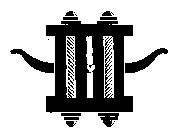CATAPULTS 
in Greek and Roman Antiquity
History
Catapults were invented about 400
BC in the powerful Greek town Syracus under Dionysios I (ca. 430-367 BC). The
Greek engineers first constructed a comparatively small machine, the gastraphetes,
sort of a crossbow. The gastraphetes was powered by a specially large
composite bow. The military effect of the new weapon during the siege of Motya
(Sicily) 397 BC encouraged the Greek engineers to enlarge the machine further.
They put a larger gastraphetes on a carriage and added a windlass to cock the
heavier machine. Certain physical barriers prevented further enlargement of the
composite bow. Therefore in mid-fourth century BC torsion springs were
introduced instead of the composite bow. The torsion spring consisted of a
bundle of rope made from horse-hair or sinew. Such a spring could be enlarged
indefinitely. The new catapults were equiped now with two torsion springs
powering the two arms of the catapult. Very soon the new design superseded the
old gastraphetes machines. Alexander the Great already employed torsion spring
catapults on his campaigns. All Hellenistic armies and all powerful Greek cities
soon owned a park of torsion artillery. Inscriptions from the Chalkothek
on the Acropolis of Athens first mention torsion spring catapults there about
330 BC. - In the 3rd century BC the two main types of catapults were
standardized: the euthytonon for
shooting arrows and the palintononfor
throwing stone balls. They now could be built after the standard calibration
formulae layed down in contemporary technical treatises. In this form Carthage
and Rome also adopted the heavy weapons. - This type of Hellenistic torsion
artillery still was employed under Augustus, when Vitruvius wrote his work.
About 100 AD the Romans redesigned the torsion artillery, developing quite
different new arrow-shooting machines. They are first shown on Trajan´s Column
in Rome. The new catapult types remained in use until Late Antiquity. In this
period also another type of stone-thrower was employed, the onager.
Representations in Ancient
Art
There are only few
representations of arrow-shooting catapults in ancient art:
Balustrade relief from the Athena sanctuary, Pergamon; 2nd century BC (Berlin,
Pergamon Museum)
Cupid gem; Late Hellenistic or Augustan (from the Tommaso Cades
collection)
Relief from Rome, Armilustrium(?); Flavian (Florence, Palazzo degli
Uffizi)
Relief on tombstone of Vedennius, Rome; end of first century AD (Rome, Musei
Vaticani)
Several reliefs on Trajan´s Column, Rome.
Photos of the reliefs are
reproduced in: Schramm 1918 - Marsden 1969 -
Baatz 1994 (see bibliography)
No representation of a
large, stone-shooting machine is known so far.
Ancient Technical
Treatises
From the 3rd century BC onward
Greek and Roman engineers published detailed treatises describing catapults.
Most of them were provided with technical text figures. They supply
basic knowledge for the understanding and reconstruction of the weapons. The
most important are:
Philon,
Belopoeica - Heron,
Belopoeica - Vitruvius, De
Architectura vol. X.10-12
Pseudo-Heron,
Cheiroballistra.
The texts are published with
English translation in: Marsden 1971 (see
bibliography).
Archaeological
Finds
The first find identified
was excavated in Ampurias (Spain) and published in 1914. Only from the
seventies of our century onwards more finds came to light from all over the
Ancient World:
Gornea and Orsova
(Romania); Sunion and Ephyra (Greece); Cremona (Italy); Auerberg
(Germany); Azaila and La Caridad (Spain); Bath and Elginhaugh (Great
Britain); Lyon (France); Pergamon (Turkey); Hatra (Iraq); Pityus (Georgia);
Mahdia (Tunisia); Sala and Volubilis (Maroc). The new finds considerably improve
our knowledge and throw light on certain trends of ancient technical
development. For publication of finds see
bibliography.
Catapults in ancient art
Archaeological finds
Reconstructions
Bibliography
German version
© D.
Baatz, D-64297 Darmstadt, Germany
Vers. 18 October, 2001